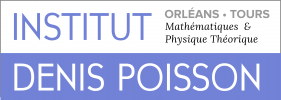Séminaire de Physique Théorique
Interfacing analytical and numerical modelizations of coalescing binaries: a status reportAlessandro Nagar (IHES)
Thursday 02 December 2010 11:00 - Tours - Salle 1180 (Bât E2)
Résumé :
Currently operating ground-based gravitational wave (GW) detectors LIGO/VIRGO/GEO are currently taking data at the designed sensitivity. Coalescing black-hole binaries and inspiralling neutron star binaries are among the most promising sources of gravitational radiation for these detectors. For the detection to be successful, one needs to know in advance, with sufficient accuracy, the gravitational waveform, so to build accurate "template waveforms" able to extract the signal out of the detector's noise. I will review recent efforts in this direction that are based on the sinergy between numerical relativity calculations, i.e., the numerical solution of Einsten's equations on a supercomputer (in full generality) and analytical calculations based on a suitable resummation of post-Newtonian theory. In particular, this analytical approach, known as the Effective One Body (EOB) approach to the (general relativistic) two-body dynamics, has proven itself successful to (i) extract crucial nonperturbative information from numerical relativity waveform data; (ii) to build accurate template waveforms for coalescing black-hole binaries that can be efficiently used for GW data analysis purposes; and (iii) to accurately model also neutron star binaries dynamics and waveforms, thanks to a suitable modelization of tidal effects (theory of relativistic Love numbers).
Liens :
